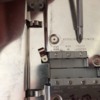Just curious - what is the advantage to having your switch lanterns being lit and being able to throw your switches without track power being on, either conventionally or command ?
It's nice not drawing from track power, especially in conventional. I used to use 027 stye track and switches on my portable layout, but sold all that off and switched to O gauge for this and other reasons.
If you were doing switching in conventional you could just put the train in neutral and throw your switches. Switching in conventional is a pain in general.
The fixed voltage concept predates command control in 3 rail O by close to 50 years. It doesn't matter as much with command, though if you are still using incandescent bulbs, you do run the risk of melting the lanterns at full voltage. LED's will fix that.
Maybe the best reason to power from a fixed source is the non derailing feature won't work if the voltage is too low. It also looks silly having the lights go up and down as you move the throttle.






